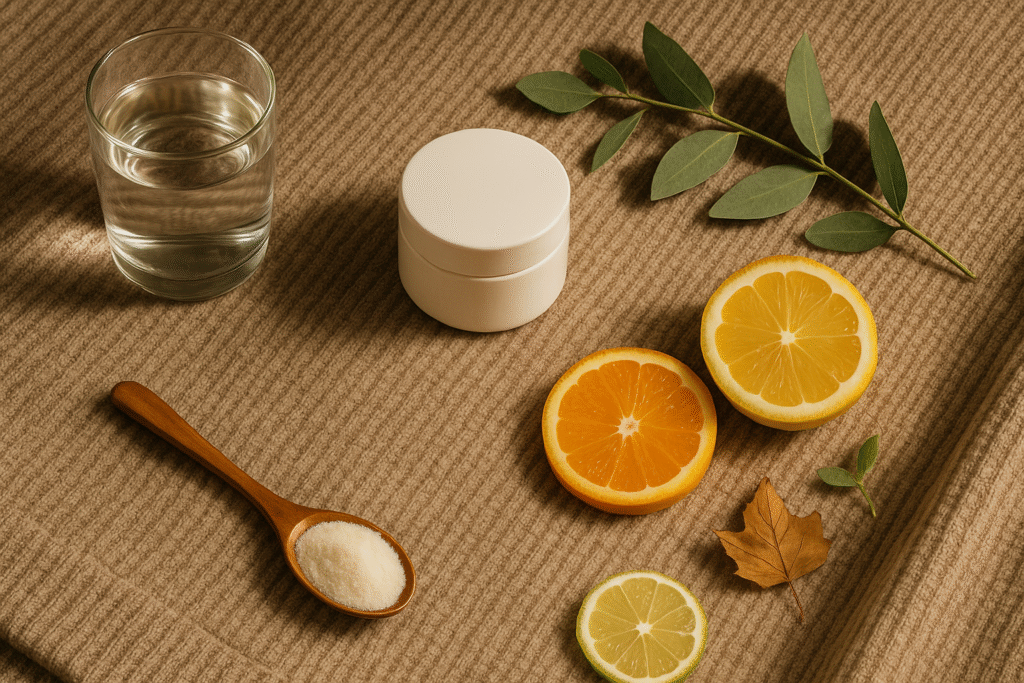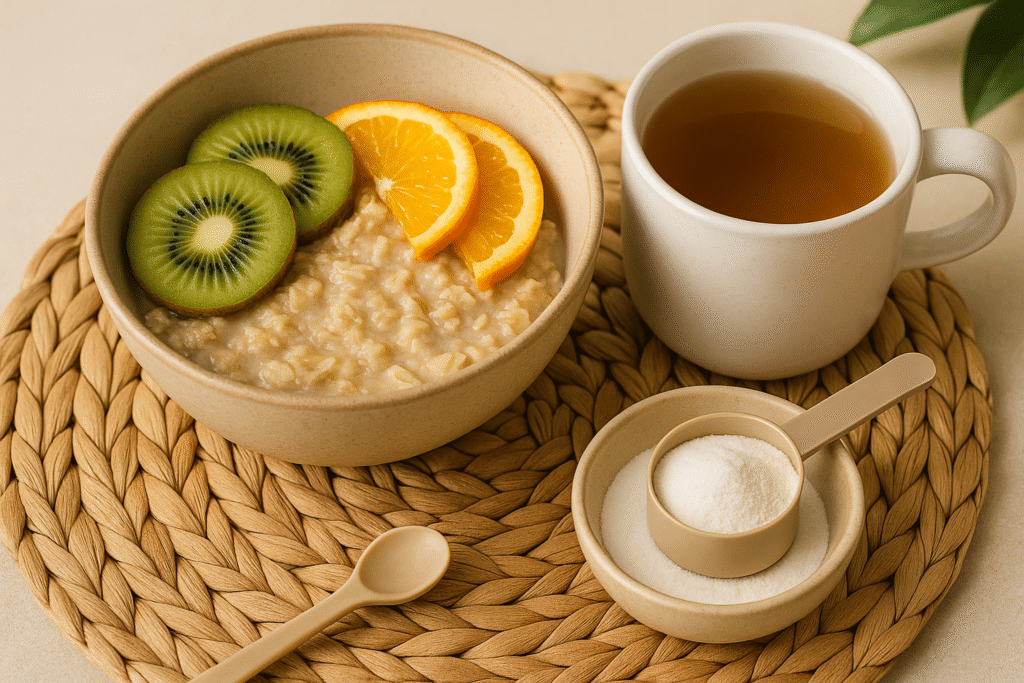Skin Health
Skin Support Ultimate Guide: Avoiding Autumn Dryness from the Inside Out
Skin support becomes especially important in autumn, when cooler air, lower humidity, and indoor heating can sap moisture from the skin’s surface. Windy days and lingering UVA exposure add to the stress, leaving many people with a tight, dull, or flaky complexion by mid-season. The good news: thoughtful shifts in lifestyle, diet, sleep, and a steady, inside-out approach with collagen can help your skin feel comfortable and look more resilient as the weather changes.

Why fall is tough on your skin
- Lower humidity + indoor heat accelerate water loss from the skin’s surface, which can compromise the moisture barrier.
- Wind + temperature swings may increase irritation, especially on cheeks and around the nose.
- Sun is still a factor: UVA rays penetrate clouds and glass year-round, so daily protection remains relevant in fall.
Lifestyle habits that pay off
- Short, lukewarm showers (not hot): aim for 5–10 minutes. Pat dry; apply moisturizer while skin is slightly damp.
- Humidify your spaces: a bedroom humidifier or adding moisture near a heating source can raise ambient humidity.
- Gentle cleansing: use a mild, pH-balanced cleanser once or twice daily; avoid over-scrubbing.
- Daily protection: cover exposed areas on bright days (hat, sunglasses) and protect hands/neck/face.
- Fabric choices: soft, breathable layers (avoid scratchy scarves on reactive skin); wash new knits before wearing.
Diet: inside-out hydration and barrier nutrients
Build each meal so it naturally supports skin support while the air gets drier.
1) Hydration strategy (all day):
- Keep a refillable bottle handy; aim for steady sips of water and unsweetened herbal teas.
- Add brothy soups, watery produce (cucumber, citrus, grapes), and oatmeal for fluid + soluble fiber.
- Go easy on alcohol and late-day caffeine—they can feel dehydrating or disrupt sleep.
2) Protein as the anchor (each meal):
- Include a protein source at breakfast/lunch/dinner (eggs, poultry, fish, tofu, Greek yogurt, legumes).
- Protein provides amino acids used for routine tissue maintenance; many adults also include hydrolyzed collagen peptides as an inside-out complement in fall (see collagen section below).
3) Vitamin C partners (support normal collagen formation):
- Add citrus, kiwi, bell peppers, berries to meals/snacks. A simple rule: pair protein or collagen with a vitamin C–rich food during the day.
4) Healthy fats for comfort:
- Work in omega-3s (salmon, sardines, walnuts, flax/chia) and vitamin E–rich foods (almonds, sunflower seeds).
- Cook with olive oil and add avocado or tahini for satiety without heaviness.
5) Minerals & colorful plants:
- Leafy greens and orange vegetables (spinach, kale, sweet potato, carrots) bring carotenoids and minerals like magnesium and potassium.
- Zinc sources (beans, lentils, pumpkin seeds) round out a balanced plate.

Sample fall day (idea starter):
- Breakfast: Oatmeal cooked in water, topped with kiwi and pumpkin seeds; side of Greek yogurt.
- Lunch: Salmon, quinoa, and arugula/bell-pepper salad with olive oil + lemon.
- Snack: Apple slices with almond butter; herbal tea.
- Dinner: Chicken or tofu, roasted sweet potato, sautéed kale; small bowl of broth.
- Hydration woven throughout the day.
Sleep: your built-in nightly refresh
Skin is an organ that benefits from regular, high-quality sleep. A consistent schedule, dark/cool/quiet bedroom, and screen-free wind-down help your body do routine nightly maintenance that supports a healthy-looking complexion and ideal skin support. Wash pillowcases frequently, and consider a gentle, fragrance-free moisturizer before bed to reduce morning tightness.
Collagen support between seasons: from summer stress to autumn dryness
After months of sun, heat, pool chlorine, saltwater, and later evenings, skin can feel dehydrated and stressed by early fall. UV exposure doesn’t just tan—over time it can stress structural proteins in the skin, and hot, dry weather may leave the surface tight or dull. When the season shifts, lower humidity and indoor heating further increase water loss, making rough patches more noticeable.
Where collagen fits: Dietary hydrolyzed collagen peptides supply amino acids (such as glycine, proline, and hydroxyproline) that the body uses for normal tissue maintenance. While overall protein intake is the foundation, many adults include collagen in autumn as a steady, inside-out complement to the basics (hydration, balanced meals, sleep, and gentle skin support). Think consistency, not overnight change.
As you compare collagen sources this fall, here’s a brief, educational note on why some adults choose porcine collagen for skin support.
Why Some Adults Choose Porcine Collagen
- Skin-like profile: naturally rich in type I & III—the same collagen types found in human skin’s matrix; commonly used in skin-focused biomaterials.
- Processing matters: look for hydrolyzed collagen (low–molecular-weight peptides) as part of a balanced diet.
- Smart pairing: include vitamin C–rich foods (citrus, kiwi, bell pepper) and steady hydration in fall.
Your autumn skin routine for skin support (5 steps, 5 minutes)
- AM cleanse (or rinse) → pat dry → lightweight moisturizer → protect exposed areas on bright days.
- Daytime: hydrate; include protein + produce at meals; shield from wind/sun as needed.
- PM cleanse (gentle) → moisturizer; add a simple, fragrance-free option when skin feels tight.
- 1–3 nights/week: keep the routine extra simple and barrier-focused (cleanse + moisturize only). If you use any exfoliation, keep it very gentle and infrequent; pause if skin feels tight or reactive.
- Weekly audit: if you notice increased dryness, reduce exfoliation and focus on barrier care.
Bonus: Autumn Skin Support Checklist
- Fill a 1-liter water bottle in the morning; aim to finish by dinner.
- Add one vitamin C–rich food to lunch and dinner.
- Keep showers lukewarm and under 10 minutes.
- Run a bedroom humidifier (or add a small water source near heat).
- Wash pillowcases frequently; avoid scratchy scarves.
- Do a screen-free wind-down for at least 30–60 minutes before bed.
- Protect exposed areas on bright or windy days.
How to use this guide
Treat autumn skin support as your skin reset: anchor the basics (gentle cleanse, moisturize, protect), support from within (protein, colorful produce, hydration, and—if appropriate for you—collagen peptides), and add just one new step at a time. Small, consistent choices build comfort—and help your skin feel steady and supported all season long.
References
Like? Share with Your Friends!

